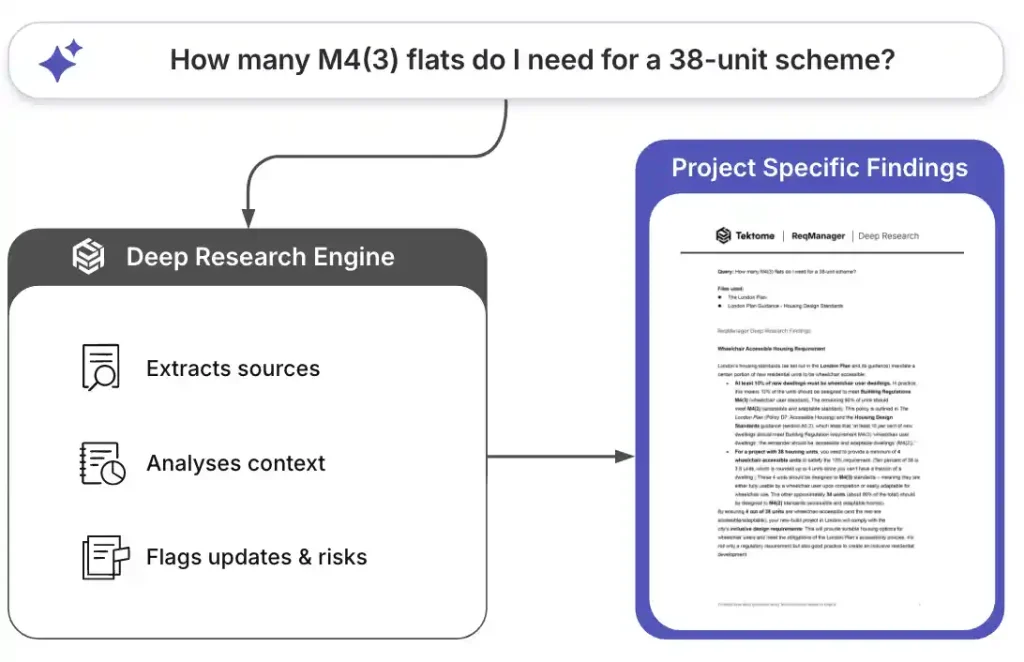The Challenge of Complex Building Regulations
Architecture, engineering, and construction (AEC) professionals know the pain of navigating building regulations. Modern building codes span hundreds of pages of technical provisions that are constantly evolving. Figuring out which rules apply to a specific project can feel like searching for a needle in a haystack. The manual process of sifting through code books or PDFs can be notoriously labor-intensive and time-consuming, not to mention prone to human error. In fact, one industry study noted that “ensuring buildings adhere to national building codes is often a labor-intensive, error-prone, and time-consuming process”. All this time spent chasing code requirements is time not spent on design and innovation.
The Hidden Cost of Manual Regulations Research
Researching regulations isn’t just tedious – it can significantly impact project schedules and costs. Traditional code compliance checks require meticulous cross-referencing of design documents against relevant codes. Consider what that entails: checking structural plans against structural codes, verifying each room against fire safety and accessibility standards, ensuring materials meet energy and environmental regulations, and so on. This multi-step review and rework cycle can drag on for weeks or even months for complex projects. As a result, project timelines stretch out, and budgets suffer from the added labor.
Why is it such a burden? A big reason is the sheer volume and complexity of building regulations. Codes can span hundreds of pages and are often open to interpretation, with dense legal language that’s hard to decipher. Keeping up with frequent updates and regional variations only adds to the challenge. Even seasoned architects and engineers struggle to stay current on every nuance. A lapse or oversight can mean missed requirements, leading to costly redesigns or compliance issues discovered late in construction. In the worst-case scenario, missing a critical regulation can pose safety risks or legal liabilities.
In short, manual regulations research drains professional time and energy. It’s little wonder that ensuring architects’ drawings adhere to building regulations is described as “labor-intensive, error-prone, and time-consuming” across the industry. As one facilities management expert put it,
code compliance can be difficult enough as it is, but the challenge is compounded by the fact that building regulations are constantly changing.
The industry has long needed a smarter way to tackle this ever-growing mountain of regulations.
Tektome to the Rescue: Introducing Deep Research in ReqManager
Imagine if you could ask an AI assistant to find and interpret the exact building regulations you need, simply by typing a question in plain language. That’s the idea behind Tektome’s upcoming Deep Research feature in ReqManager. The product is already known as “the smartest way to manage AEC requirements,” and soon it’s getting even smarter with AI-powered deep research capabilities. This new feature is designed to be a game-changer for anyone who struggles with manual code research.

How does it work? It’s straightforward and user-friendly: you write a natural-language prompt describing what you need to know, and Deep Research does the rest. Under the hood, the AI will automatically search through relevant building regulations relevant to your project, understand the context of your question, and deliver the information you actually need – complete with references to the source regulation text. Further, you have full control about which documents and regulations are checked too, however, there’s no need to know which document or section to open – Deep Research figures that out for you.
For example, suppose you’re renovating an older building and wonder “What fire escape provisions apply to a three-story mixed-use building in London?” Instead of flipping through UK Building Regulations Part B documents for hours, you could simply ask Deep Research. The AI would instantly comb through the UK regulations, find the specific clauses about fire escapes for a building of that size and use, and present you with a clear answer. You’d see a summary of the requirements – such as minimum number of staircases, exit door widths, alarm systems – tailored to your project’s details. Crucially, Deep Research would also point out exactly which regulation and section it drew the answer from (for instance, “UK Building Regs 2019, Part B Section 2, Clause 5.1”), so you can verify the source. All of this happens in seconds, not days.
From Content to Insights, Tailored to Your Project
One of the most powerful aspects of Deep Research is that it provides tailored insights, not just raw text from code books. Traditional search engines might dump a paragraph from a building code that matches a few keywords, leaving you to interpret the legalese. In contrast, Deep Research interprets the regulations for you. It reads through the dense provisions and pulls out the parts that answer your specific question. The response you get is contextualised: it understands if you’re asking about an 8-bedroom rental property vs. a 200-bed hospital, and it adjusts its findings accordingly.
Equally important, Deep Research is there to save professionals from oversights and uncertainty. By automatically scanning all relevant sources, it helps ensure that nothing critical is missed. This addresses one of the biggest worries in regulations research: the fear that an important requirement might slip through the cracks of a manual search. With AI diligently covering the ground, both junior and veteran professionals can feel more confident that they’ve caught everything they’re looking for.
A Sneak Peek into the Future
Tektome’s Deep Research in ReqManager is poised to transform how AEC teams handle building regulations research. Instead of dreading it, professionals will have an intelligent co-pilot that guides them through the regulations. Ultimately, this means architects and engineers can spend more time designing creative, compliant solutions and less time buried in paperwork.
Stay tuned for more updates about ReqManager and the upcoming Deep Research feature. In the coming weeks, Tektome will be sharing more details and live demonstrations of how this tool works on real project questions.

